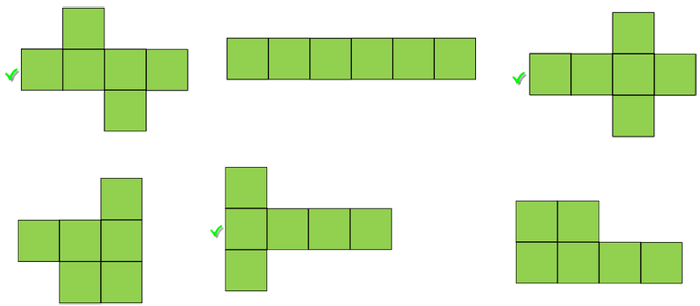Matching cubes and nets
This task can be completed with pen and paper or online (with SOME auto marking).
Students should have already had opportuntiy to create their own nets for cubes before completing this task.
Encourage students to identify all the nets that can fold to make a cube rathe rthan just one.
This resource can be used to help to identify students' understanding of identifying nets for cubes.

Item difficulties (Shapes read across each row starting at Upper left hand corner)
|
Year 4 (11/2013)
Online
|
||
| Shape 1 | Tick | moderate |
| Shape 2 | - | very easy |
| Shape 3 | Tick | very easy |
| Shape 4 | - | very easy |
| Shape 5 | Tick | easy |
| Shape 6 | - | very easy |
|
All 3 ticked (none incorrectly ticked)
2 ticked (none incorrectly ticked)
1 ticked (none incorrectly ticked)
|
difficult
easy
very easy
|
| Explanation | Examples | Performance level |
| Visual |
I pictured it
By imagining I were seeing them being folded
|
High |
| Mental / imagining |
I pretened that a was folding them in my mind and tick the ones that maked cubes.
I imagined folding them up to make cubes, and figured which ones would out from that.
|
High |
| Mental and manual |
I imagine the fold up as I move my finger the way they would fold
|
Medium |
| Prior experience |
Because I've made a cube at school.
|
Low |
| Other statements |
Because a cube has 6 sides and it has 6 sides
I matched all the nets and selected the ones that made cubes.
|
Low |
| No statement | - | Medium |
Based on a sample of 41 Year 4 students.
This resource is about visualising nets for a cube.
Most students visually identified one or more cubes correctly and typically did not incorrectly identify shapes that did not fold to make a cube.
The most common shape to not be correctly identified was the first shape shown.
Next steps
Students who could not identify all the nets for a cube or identified incorrect nets could be asked to justify (describe) how the nets fold to make the cube. If required they could be given opportunty to explore the other similar resources (for example Nets for a cube).
Students who correctly identified all 3 nets (and no incorrect answers) could be asked if there any other nets (not shown) that could be folded to make cubes - furthermore how many can they find, and have them work in pairs to check each others work.

